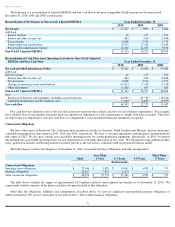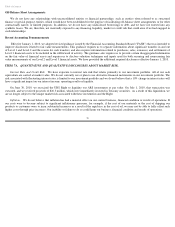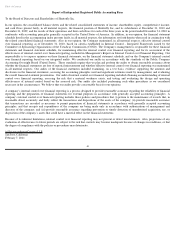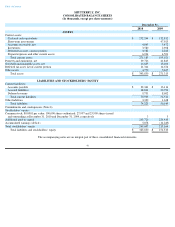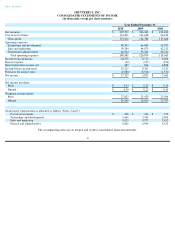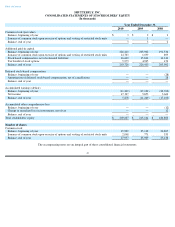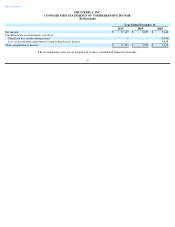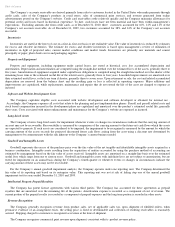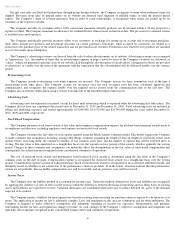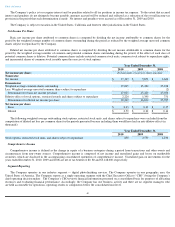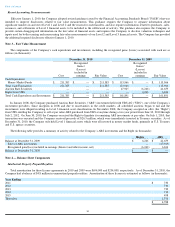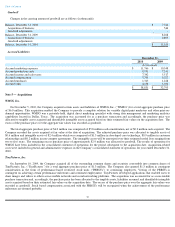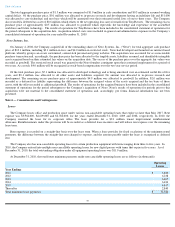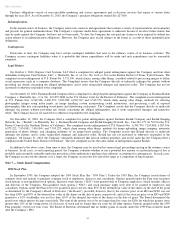Shutterfly 2011 Annual Report Download - page 54
Download and view the complete annual report
Please find page 54 of the 2011 Shutterfly annual report below. You can navigate through the pages in the report by either clicking on the pages listed below, or by using the keyword search tool below to find specific information within the annual report.
The Company’
s accounts receivable are derived primarily from sales to customers located in the United States who make payments through
credit cards, sales of the Company's products in retail stores, sales of commercial print services, and revenue generated from online
advertisements posted on the Company's website. Credit card receivables settle relatively quickly and the Company maintains allowances for
potential credit card losses based on historical experience. To date, such losses have not been material and have been within management’
s
expectations. Excluding amounts due from credit cards, as of December 31, 2010, three customers
accounted for 16%, 12% and 11% of the
Company’s net accounts receivable. As of December 31, 2009, two customers accounted for 38% and 14% of the Company’
s net accounts
receivable.
Inventories
Inventories are stated at the lower of cost on a first-in, first-
out basis or net realizable value. The value of inventories is reduced by estimates
for excess and obsolete inventories. The estimate for excess and obsolete inventories is based upon management’
s review of utilization of
inventories in light of projected sales, current market conditions and market trends. Inventories are primarily raw materials and consist
principally of paper, photo book covers and packaging supplies.
Property and Equipment
Property and equipment, including equipment under capital leases, are stated at historical cost, less accumulated depreciation and
amortization. Depreciation and amortization are computed using the straight-
line method over the estimated lives of the assets, generally three to
five years. Amortization of equipment acquired under capital lease obligations is computed using the straight-
line method over the shorter of the
remaining lease term or the estimated useful life of the related assets, generally three to four years. Leasehold improvements are amortized over
their estimated useful lives, or the lease term if shorter, generally three to seven years. Upon retirement or sale, the cost and related accumulated
depreciation are removed from the balance sheet and the resulting gain or loss is reflected in operating expenses. Major additions and
improvements are capitalized, while replacements, maintenance and repairs that do not extend the life of the asset are charged to expense as
incurred.
Software and Website Development Costs
The Company capitalize eligible costs associated with website development and software developed or obtained for internal use
.
Accordingly, the Company expenses all costs that relate to the planning and post implementation phases. Payroll and payroll related costs and
stock based compensation incurred in the development phase are capitalized and amortized over the product’
s estimated useful life, generally
three years. Costs associated with minor enhancements and maintenance for the Company’s website are expensed as incurred.
Long-Lived Assets
The Company reviews long-
lived assets for impairment whenever events or changes in circumstances indicate that the carrying amount of
an asset may not be recoverable. Recoverability is measured by comparison of the carrying amount to the future net cash flows which the assets
are expected to generate. If such assets are considered to be impaired, the impairment to be recognized is measured by the amount by which the
carrying amount of the assets exceeds the projected discounted future cash flows arising from the asset using a discount rate determined by
management to be commensurate with the risk inherent to the Company’s current business model.
Goodwill and Intangible Assets
Goodwill represents the excess of the purchase price over the fair value of the net tangible and identifiable intangible assets acquired in a
business combination. Intangible assets resulting from the acquisition of entities accounted for using the purchase method of accounting are
estimated by management based on the fair value of assets received. Intangible assets are amortized on a straight-
line basis over the estimated
useful lives which range from one to sixteen years. Goodwill and intangibles assets with indefinite lives are not subject to amortization, but are
tested for impairment on an annual basis during the Company’
s fourth quarter or whenever events or changes in circumstances indicate the
carrying amount of these assets may not be recoverable.
For the Company’
s annual goodwill impairment analysis, the Company operates under one reporting unit. The Company determined the
fair value of its reporting unit based on its enterprise value. This reporting unit was not at risk of failing step one of the annual goodwill
impairment test for years ended December 31, 2010 and 2009.
Intellectual Property Prepaid Royalties
The Company has patent license agreements with various third parties. The Company has accounted for these agreements as prepaid
royalties that are amortized over the remaining life of the patents. Amortization expense is recorded as a component of cost of revenue. The
current portion of the prepaid royalty is recorded as a component of prepaid expenses and the long term portion is recorded in other assets.
Revenue Recognition
The Company generally recognizes revenue from product sales, net of applicable sales tax, upon shipment of fulfilled orders, when
persuasive evidence of an arrangement exists, the selling price is fixed or determinable and collection of resulting receivables is reasonably
assured. Shipping charged to customers is recognized as revenue at the time of shipment.
The Company recognizes commercial print revenue upon shipment, consistent with its product revenue policy.
Table of Contents


